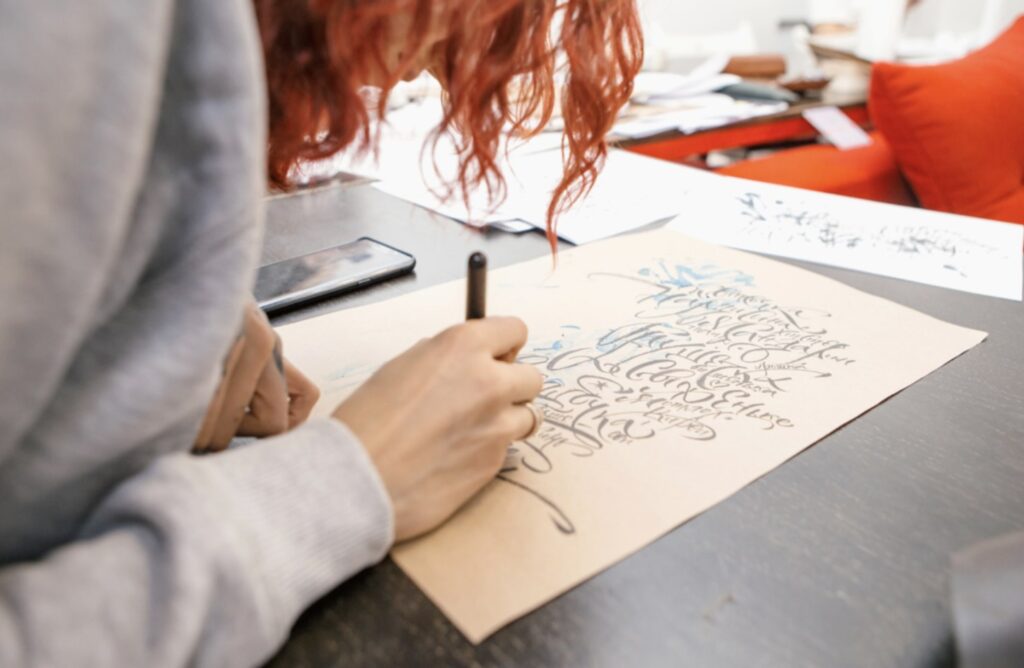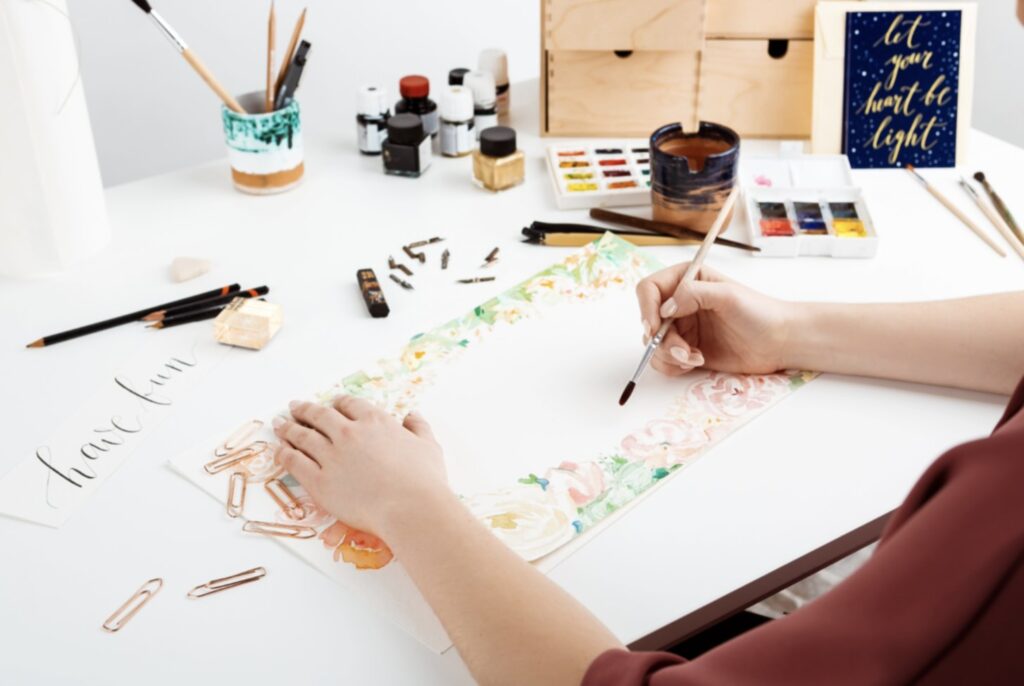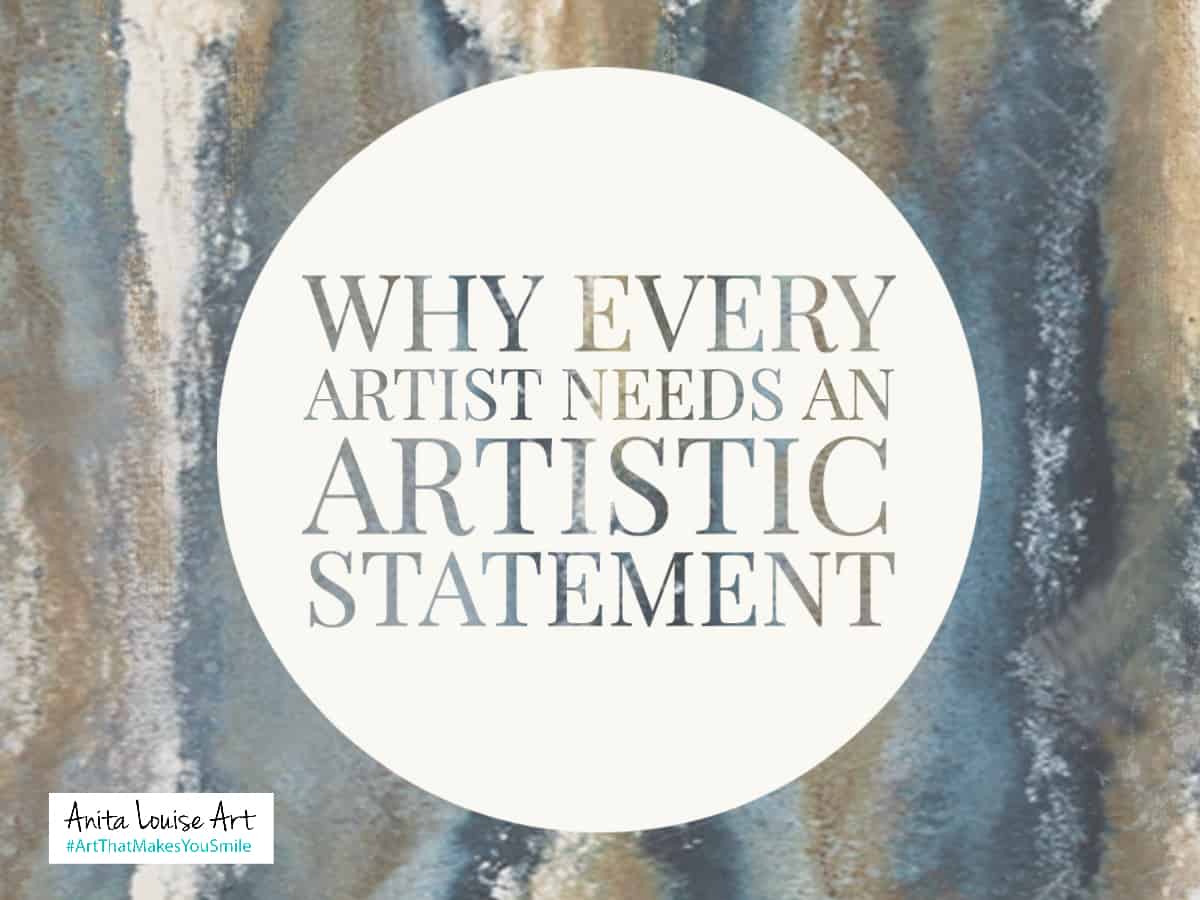Many artists neglect the very simple process of sitting down to write their artistic statement. Other artists may not fully understand what all the talk about an artistic statement is about.
An artistic statement is a statement of the artist and their artwork. It is an essential part of your art branding and marketing, yet many artists write a very poor artistic statement that no one really wants to read. There are steps you can take to write a grand artistic statement. We believe every artist can benefit from a clear, concise, and well-written statement.
Table of Contents
- What Is An Artistic Statement?
- A Poor Statement Can Hurt You and Your Artwork
- How To Write A Great Artistic Statement
- Summary of What Makes a Good Vs. Bad Artistic Statements
- Related Content:
What Is An Artistic Statement?
An artistic statement is a concise statement about the artist and their artwork. It can help to answer some questions about you and your artwork in a concise and hopefully entertaining manner so that people will want to know more about you and your art.

Simple format you can use for your artistic statement
Introduce Yourself
Tell a bit about yourself. What motivates you to do your artwork? Maybe you can paint a lot of scenes from your area? Or maybe you can paint outdoors? Let people know briefly what inspires you and your art.
Explain Your Work
Explain to everyone in a few words about your artwork. How do you approach your work? When writing this think about your audience and what they want to know.
This is like a short elevator speech. You know that speech where you are on an elevator, and someone asks you what you do? You have just a few minutes to explain to them what you do and why you do what you do it
Organize Your Thoughts
A well-thought-out artist statement helps you to organize your thoughts. This will also help you to define your art brand.
Art can be very personal in nature, and for many artists, when they pour their heart and soul into their work, it can be hard to talk about their art for fear of rejection. But a well-thought-out artist’s statement can help to give you confidence in your work, as it will help you to be able to present your artwork to others in a very meaningful yet concise way.
A Poor Statement Can Hurt You and Your Artwork
An artist’s statement is essential but a poorly written one can turn people off from your artwork and can even hurt your chances at success. This is why having a well-written and thought-out artist’s statement is essential.
In speaking of this, Daniel Grant in the Huffington Post wrote this about some art gallery owners and artistic statements:
“Most art dealers claim that an artist statement is never an important consideration in selecting an artist to show or represent and that a poorly written statement may have a detrimental effect if the artist’s slides had otherwise interested the dealer. No one believes that an artist should be judged on the basis of his or her command of the English language but, as Philadelphia, Pennsylvania gallery owner Charles More noted, “a badly written statement colors the work negatively for me.”
Daniel Grant – HuffPost
What this is really saying is not that an artist’s statement is bad, but that so many artists do such a poor job in writing them that it may hurt them and not help them and their artwork. This is why a well-written artist’s statement can help you stand out from other artists.

How To Write A Great Artistic Statement
So, how do you write one of those great artists’ statements that people will love to read? First, you should take the time to do your homework so you know what kind of artistic statement you want to write.
Some ways you can do your homework for your artistic statement:
Look At The Statements of Artists You Admire
Go on to the website of some artists you admire and read their artist’s statements. Take notes as to what you liked and did not like about their statements.
If an artist is famous, there is a very good chance they did not write the statement themselves but had some professionals helping them write it. Those statements you should look at will give you an idea of how the professionals are writing the statements.
Go Outside the Art Field
Look at bios and statements of others outside the art field. Look at many of the sports heroes, actors, and others. Most of them would have had a team of professionals working on their personal statements and bios. Look at what you like and do not like about their statements and then take notes.
Be The Guide, Not The Hero
This is perhaps one of the hardest things for anyone in telling their story is that we are the guide and not the hero of the story. Your artistic statement needs to speak not to you but to the people who will read it. In other words, no matter how much you want this to be about you and your art, it really is not – it is about the people who are going to buy your work.
Humanize and Add Humor
We are all human, and people want to know you are also human. Being personable and human in your artist’s statement can go a long way to help you with your statement. People really do not want to read a long list of your educational pursuits, art shows, newspaper clippings or PhDs. They want to know who you are as a person.
Summary of What Makes a Good Vs. Bad Artistic Statements
Here is our summary and inside scoop on what makes a good and a bad artist’s statement. If you follow these few things, you will be just fine.

What makes a good artistic statement:
- Keep It Short – most people will only read a few sentences anyway.
- Get Attention – grab the reader’s attention from the first sentence.
- Show Your Personality – Show your personality and who you are.
- Show Enthusiasm – Let others know about your enthusiasm for your art and subject matter.
- Why you do what you do – Tell others what drives you to paint or do your artwork.
- First-person- Use the first person for your languages ie I, me, mine). In other words, take full ownership of your artwork.
This is what makes a bad artistic statement:
- Long, boring resume – No one wants to read a long list of accomplishments or a long resume. This is not a job interview. Save that for a page on your website.
- Too generic – Your work is personal so the statement must also be personal.
- Using too big or essential words – Some people want to show how smart they are or how much education they have so they use too big and important words most people do not understand.
- Unclear – The statement should be clear and not filled with all these hidden meanings that no one understands. Your artist statement should not be an Agatha Christie Mystery.
If you take these steps and do your homework, then you should be able to write a unique artistic statement. And that fantastic` art statement will truly allow you to stand out in the crowd.
Anita Louise Art is dedicated to art education, great artists, and inspiring others to find and create their art. We love art that uplifts and inspires. #ArtToMakeYouSmile! #ArtToMakeYouHappy!
If you want to see any of my art, you can find out more by clicking here. If you are interested in what inspires me and my paintings, you can discover more by clicking here.
We have a free newsletter and would love you to be part of our community; you can subscribe to the newsletter by clicking here. If you have any questions, I would be happy to talk to you anytime. You can reach me, Anita, by clicking here.
Subscribe to our Anita Louise Art YouTube Channel with great videos and information by clicking here.
Join us for our podcast “5 Minutes With Art.” just 5 minutes a week with us to discover and learn about great art and artists. You can find out more about our podcast by clicking here.
Related Content:
Does An Artist Art Brand Need a Logo?
We believe every artist should have a logo to brand their art and art business. A great logo will give added attention to you and your artwork. A brand logo will show the world you are a professional artist as you have taken the time to design a logo. Your brand logo should have the right style, colors, and font to give the message of you and your artwork clearly.
To find out more you can read our blog on Does An Artist Art Brand Need a Logo? by clicking here.
Should An Artist Have a Facebook Page?
The 7 reasons why every artist should consider having a Facebook page. The reason are that 1) Facebook is the largest social media platform in the world, 2) your competition will probably have a Facebook page, 3) with Facebook you can tell people about you, your art and your art brand, 4) you can build an art community, 5) it helps you with your search engine optimization, 6) gives you a way to have daily contact with potential customers and 7) it is free to use.
To find out more you can read our blog on 7 Reasons Every Artist Should Have a Facebook Page by clicking here.

